




The authorities immediately contacted Jean Yves Empereur and his team of archeaologists. The place where the dike was being built was also the place where the mythical lighthouse of Alexandria stood.
In 97, after months of diving and careful research, Jean Yves Empereur and his team were proud to announce to the world that they had found on of the seven wonders of the world: The Pharos of Alexandria. (see my page about the pharos)
In 98, in order to lighten the traffic jams in Alexandria, a big highway crossing the city in direction of the industrial haven is being built. Due to the immense population density, the highway is built just next to the flatblocks where thousands of Egyptians are living. The highway had nearly reached the heaven when the works suddenly stopped. The workers had discovered underground rooms while boring holes for the highway. Jean Yves Empereur's teams directly came to the spot.
The place where the highway was being built had been used by the Greek as a big cemetary called the Necropolis, the city of the dead. For the first time in 2000 years, the city of the dead and the city of the living were brought together again. The archaeologists got the authorisation to search the site to save as much objects as possible. During the first day, they discovered lots of underground rooms containing tombs that had been damaged by the construction of the highway. Some rooms were already filled with concrete. They knew they had to be quick because the governement wouldn't stop the construction works of the highway for a very long time, too much money was involved. In order to find their way accross the rooms they were visiting, the archaeologists began to draw very detailled plans of the underground structure. After some days of research, the pressure was growing because they couldn't find any access to the rooms that were supposed to be hidden under the highway and the city. Boring holes from the surface could seriously damage the whole tomb complex so they had to find an entrance. It seemed that they would never find an entrance until...

Bala was then nicknamed "the smuggler" because in the Greek mythology, the dead was brought to the underworld by a smuggler called Charon. Bala had found a way digged by plunderers which led him into several tombs.
Thanks to Bala, the archaeologists had found the entrance of a huge tomb complex. They could each time access the rooms by circular holes that had been digged by plunderers a long time ago. All the tombs had been plundered but some of them were still in a very good state. Skeletons, vases, plates and other ancient objects were found. Sometimes the name of the dead was still written in Greek on the top of the tomb. Some christian crosses were also found which means that the Necropolis had been used for centuries.
In the mouth of each skeletons, a copper coin was found. In the Greek mythology, the dead had to pay his passage to Charon the smuggler. That's why each dead was buried with a copper coin in his mouth. Some skeletons were really well preserved and became a good source of information for paleontologists. Hundreds of tombs were discovered and the archaeologists knew they would have enough time to discover all the rooms that were still hidden so they decided to accelerate the researches in direction of the industrial haven (that's where the highway is going to be built). They suddenly encountered a new problem, some rooms were filled with water. They tried to pump out the water but it was useless because the level and the stream of the underground water was too high. So they decided to dive and explorer the hidden rooms. It was a dangerous journey into the world of the dead, the water was gloomy and the scuba-divers could easily get stuck somewhere. Lots of objects were brought to the surface.
Jean-Yves Empereur could remain indifferent in front of what he had discovered with his team. He wanted to find a compromise to save the Necropolis without preventing the highway from being constructed. He thought of a huge underground museum where tourists could visit the Necropolis while the trucks could easily use the highway above the museum. His project never came true and the Necropolis crumbled under the heavy weight of the new highway, leaving the city of the dead to tragic fate.
Further reading: (in association with Amazon.com)
"Alexandria: The sunken city" by William La Riche
List price: 35 US$ Your price here: 24.50 US$
Review:
The recent excavation of an underwater locale in Egypt yielded an awesome collection of artifacts, inlcuding huge architectural and scultural fragments. La Riche's stunning book documents these discoveries, telling the story of the Egyptian-French research team that carried out the project to map the Pharos site, going on to unearth thousands of precious relics from the ancient Alexandrian civilization. (American library association)
Click here for more information about the book.